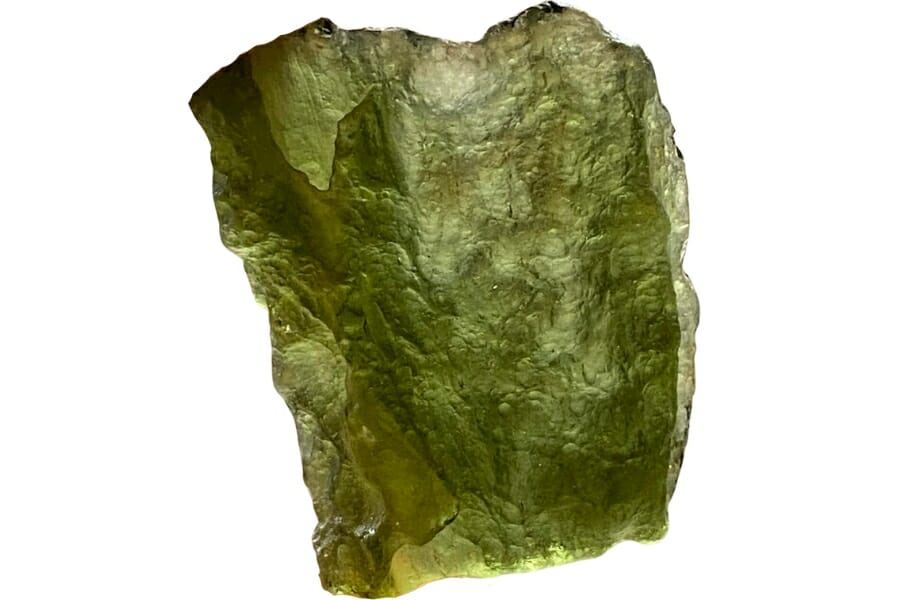Can you imagine a stone that comes from deep within our planet and another that has ties to outer space? Sounds like a plot for an exciting movie, but these are stories of two real stones: malachite and moldavite.
While they might look different to our eyes, these two stones have many traits that connect them and characteristics that set them apart. In this article, we’ll compare malachite vs moldavite to get to know these details.
As we dive deeper, you’ll discover fascinating facts and feel a new appreciation for these two natural wonders. By the end, you’ll be able to tell malachite and moldavite apart without having to be an expert. Let’s begin!
Malachite vs Moldavite – The Major Differences
Despite sharing equally interesting formation stories, there are a handful of differences between malachite and moldavite. Below are the major ones that will help you tell one from the other.
Color and Appearance- Malachite has a vibrant green color and opaque looks
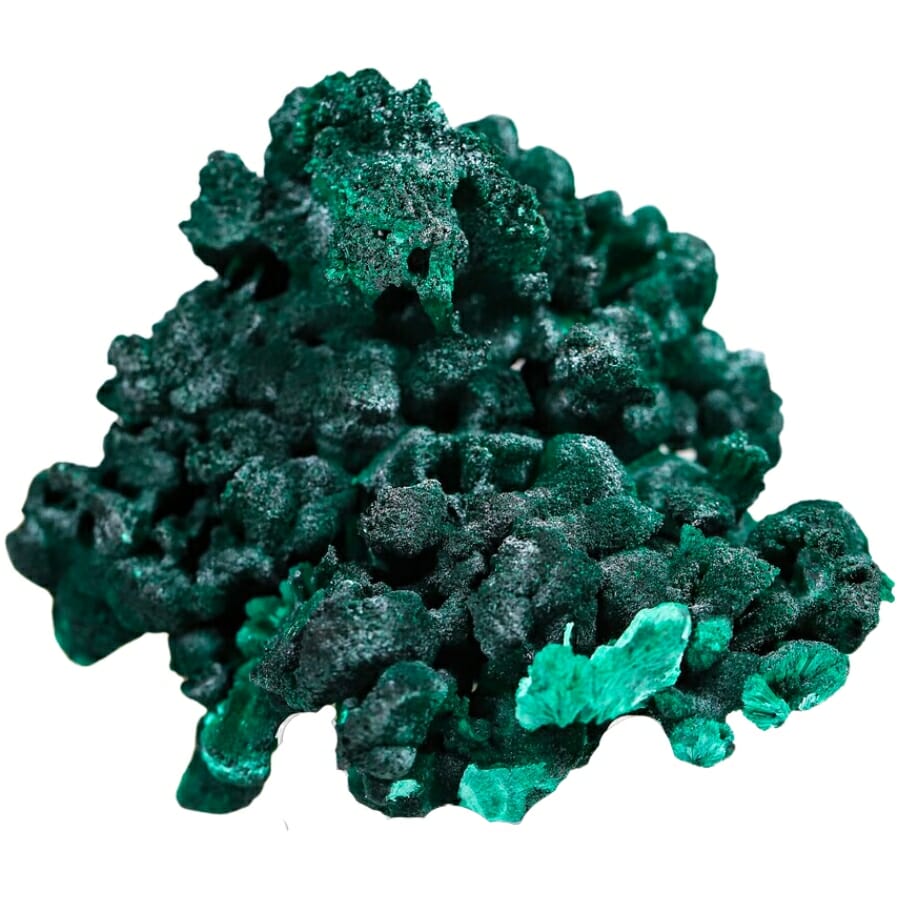
When you see malachite, you’ll instantly notice its bright green color. It’s like the vibrant greens you see in forests or jungles. But what makes it even cooler is the unique way the green shows up.
The stone has swirly, banded patterns that can make it look like a piece of art. Some pieces of malachite have light and dark green bands swirling together, while others might just have one shade of green.
Moldavite is also green, but its color is a bit different. Imagine the deep, mysterious green of a bottle or the color of green olives. That’s the kind of green you’ll often find in it.
But there’s more! Moldavite is somewhat see-through or translucent. This means that if you hold it up to the light, it might look a little like a rough piece of green glass. It also usually has an uneven or bumpy surface.
Luster – Moldavite has a glass-like luster
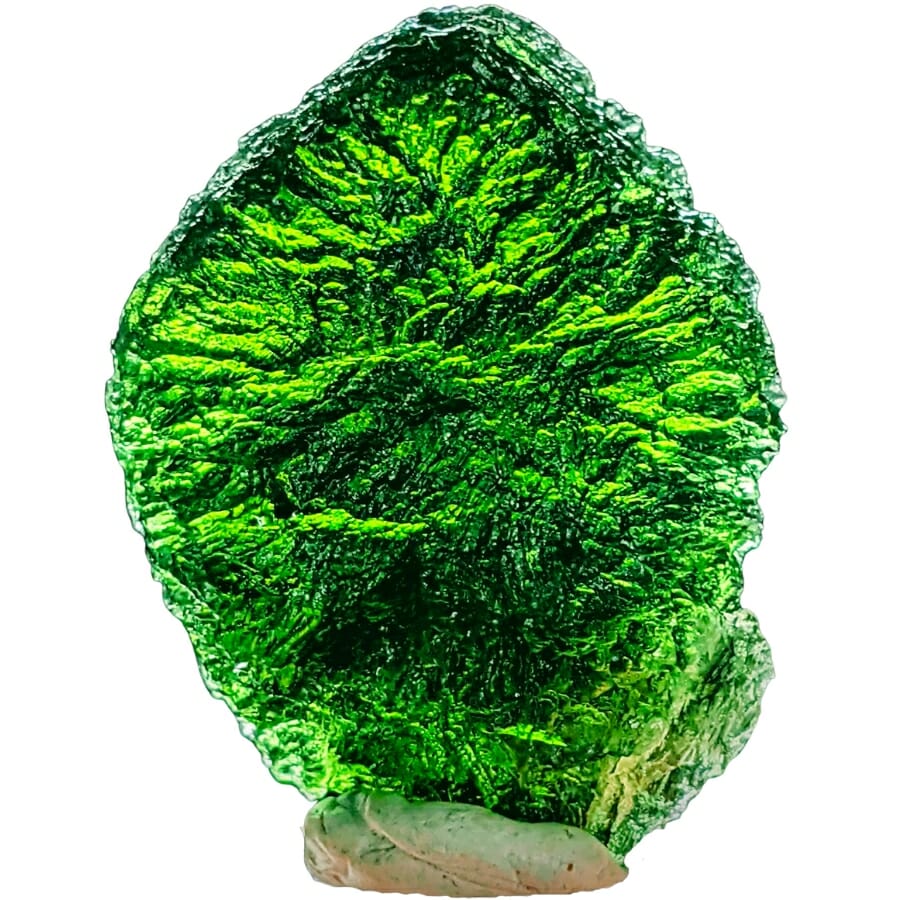
Luster describes how a mineral or stone reflects light. Imagine looking at a shiny new car and then at a piece of chalk. They reflect light differently, right? Malachite and moldavite are just like that.
Malachite isn’t super shiny. Instead, it has a look that’s somewhere between silky and earthy. Picture the soft glow of satin or the muted sheen of a clay pot. That’s the kind of shine you can expect from it. It’s not super bright, but it’s not dull either.
On the other hand, moldavite is quite different. As we said above, it can look a bit like rough green glass because of its vitreous luster. So, moldavite reflects light much like a piece of glass would.
When you look at a piece of moldavite, you’ll notice it has a brighter, more sparkling shine compared to malachite.
Cleavage – Malachite has a perfect cleavage in one direction
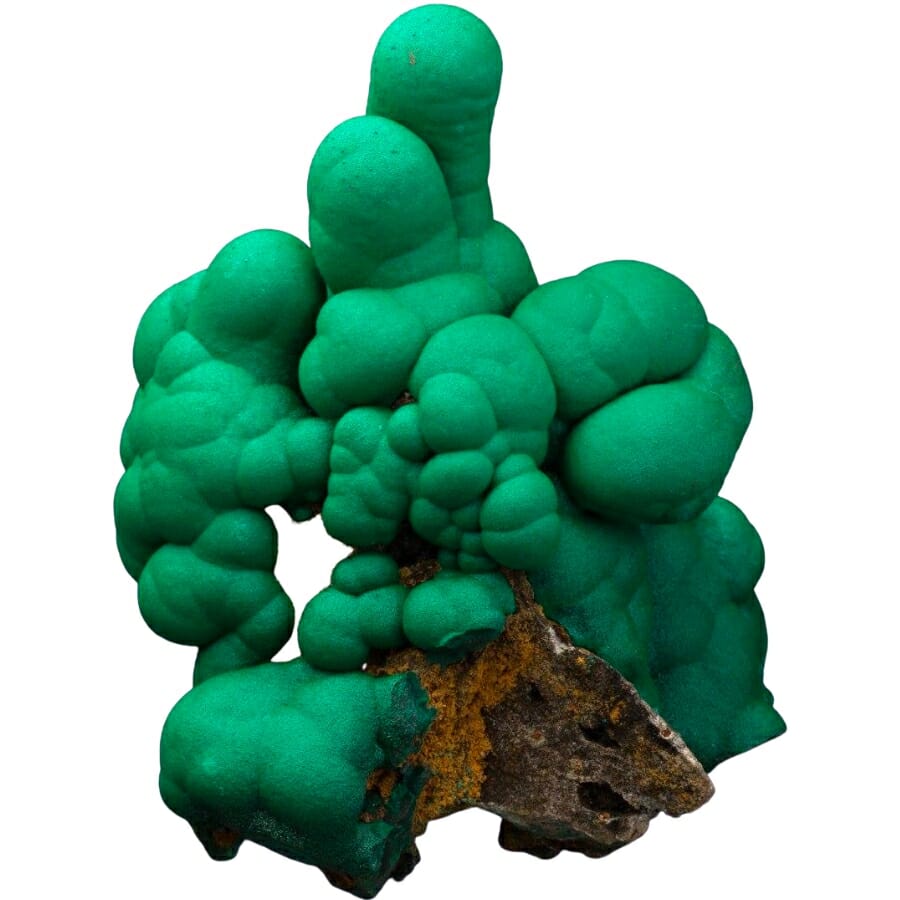
Cleavage refers to the way a mineral breaks along certain planes or flat surfaces. It’s like how some chocolate bars are made with sections that let you break off a piece easily.
Malachite has what’s called perfect cleavage in one direction. This means if you tried to split or break it, it would most likely break smoothly in one specific direction.
In comparison, moldavite doesn’t have cleavage like malachite. Instead, it breaks with what’s called a conchoidal fracture. Imagine how broken glass looks, with its curvy and shell-like breaks. That’s how moldavite breaks.
Crystal Structure – Moldavite has no crystal structure
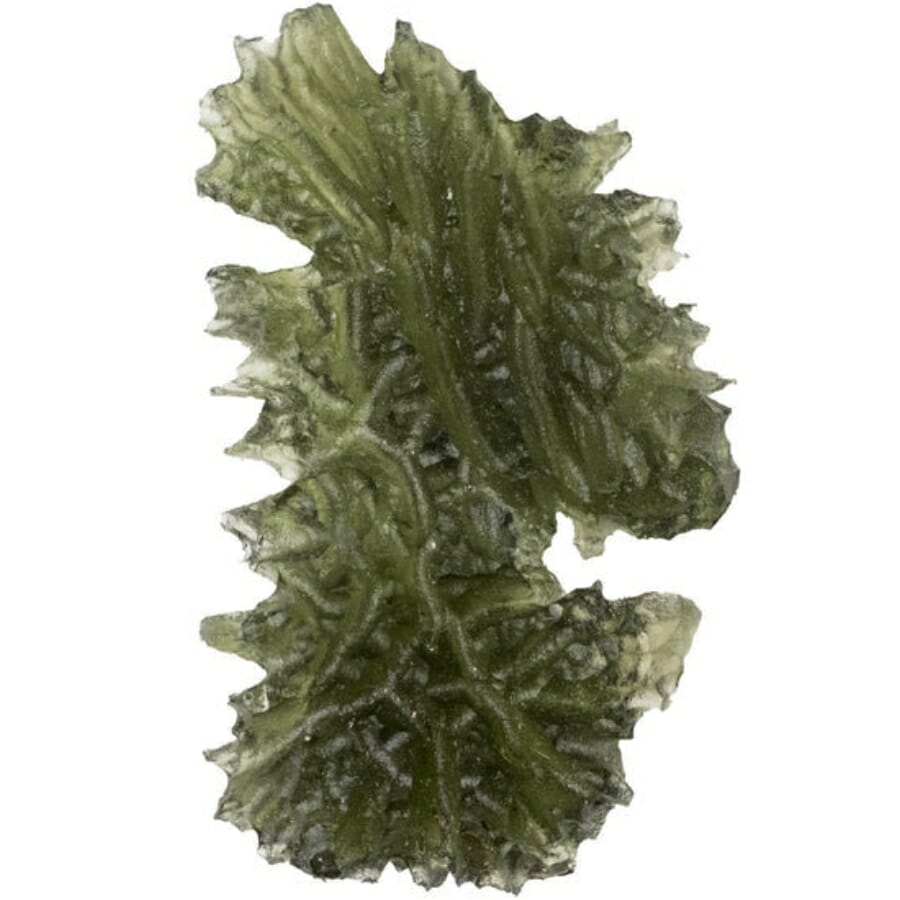
Every mineral has a unique way its atoms are arranged, kind of like how every house has a different floor plan. This arrangement is what we call crystal structure.
Malachite has what’s known as a monoclinic crystal structure. It’s like a wonky box where not all the sides and angles are equal. But remember, even if the structure is wonky at the atomic level, the outside of malachite can look smooth and banded.
As for moldavite, well, it doesn’t have a crystal structure at all! Instead, it’s amorphous, which means its atoms are not arranged into a specific pattern.
This is because moldavite was formed from a super hot meteor impact. Its atoms rapidly combined and just randomly jumbled together as it was cooling down and turning into a rock.
Hardness – Malachite is easier to scratch
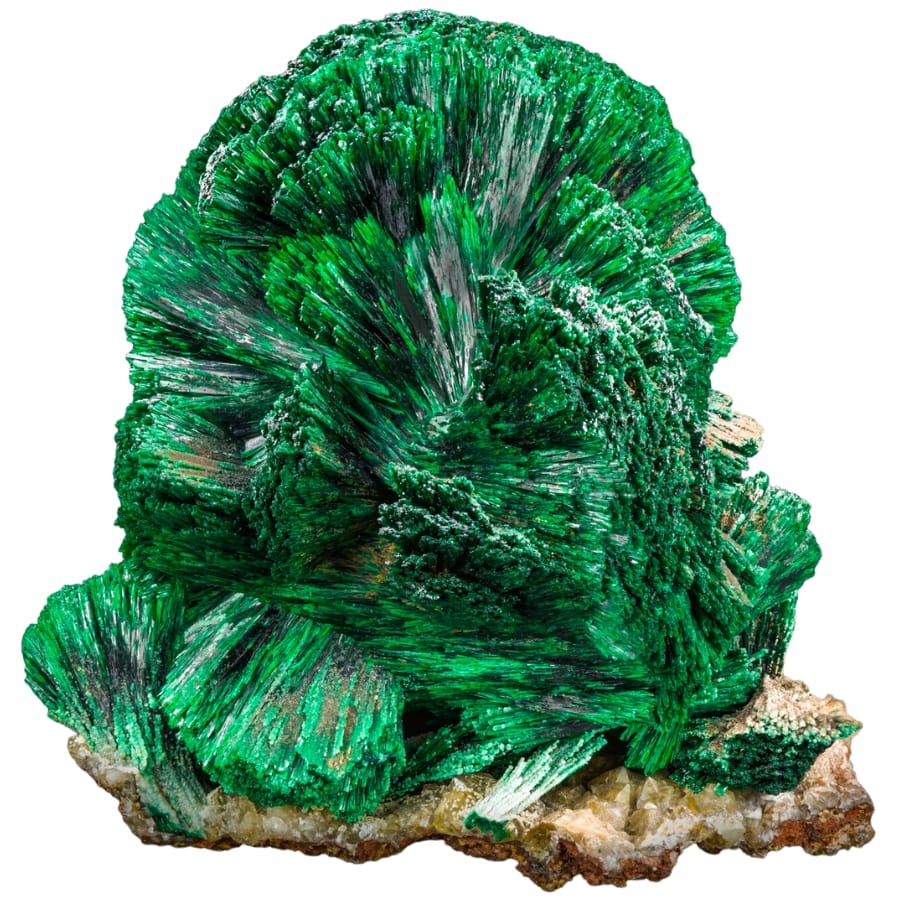
Think of hardness as a measure of how tough or scratch-resistant a mineral is. It’s like comparing a soft rubber eraser to a hard metal nail.
Malachite isn’t super hard, but it’s not too soft either. On the Mohs scale of hardness, it gets a score of around 3.5-4.
To put that in perspective, your fingernail is about a 2.5 on the same scale. So, malachite is harder than your fingernail, but it’s still considered somewhat soft compared to many other minerals.
Meanwhile, moldavite is a bit tougher than malachite. It scores around 5.5 on the Mohs scale. This means it is more resistant to scratches. Because moldavite is more like glass, it’s got a harder and sturdier feel.
Density – Moldavite is lighter than malachite
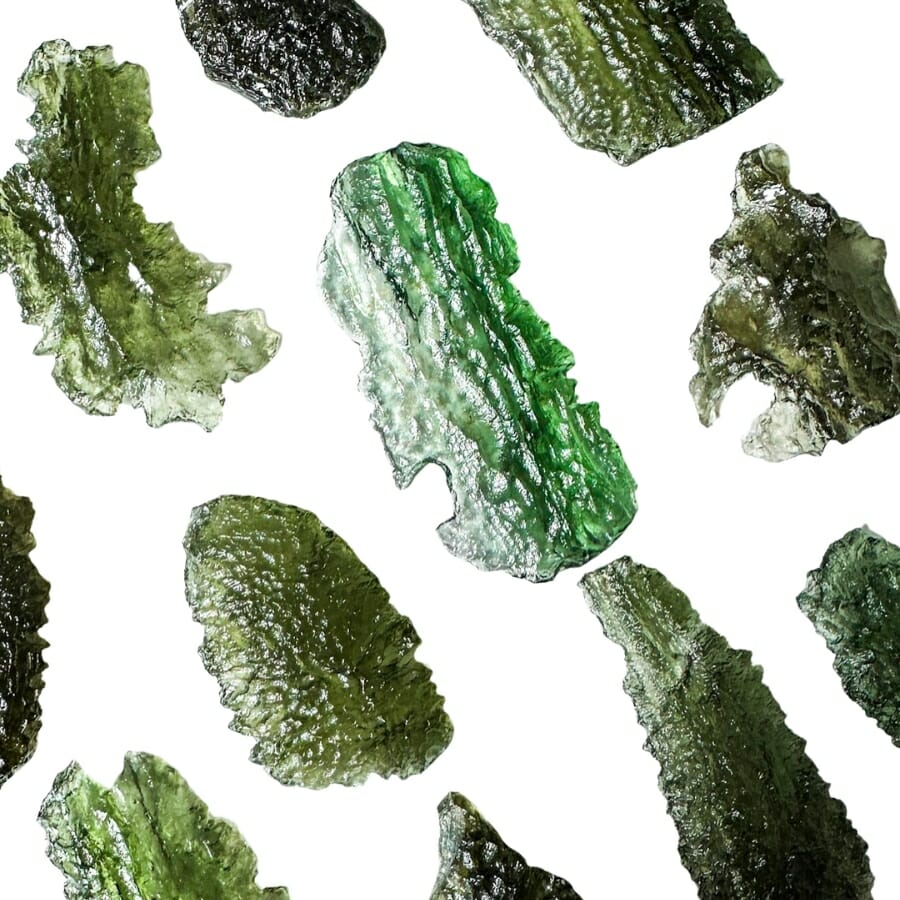
Density is a way to describe how much mass is packed into a certain amount of space.
Malachite has a density of about 3.6 to 4.0 g/cm^3. In simpler terms, a cube of malachite would weigh a bit heavier than the same cube filled with water.
Moldavite, meanwhile, has a density that ranges from 2.32 to 2.38 g/cm^3. Using our cube example, if that cube was made of moldavite, it would weigh a bit heavier than water, but still lighter than malachite.
So, what does this all mean? If you had a piece of malachite and a piece of moldavite that were the same size, the malachite would feel heavier in your hand.
Composition – Malachite is mainly made of copper
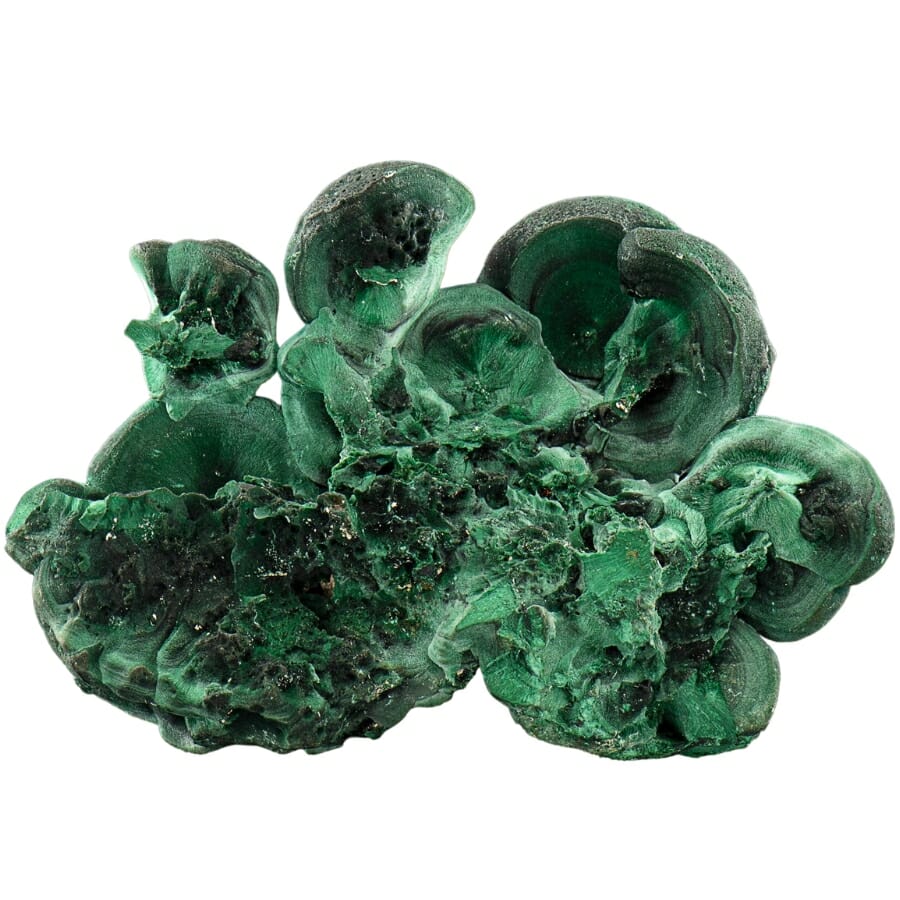
Malachite is made mainly of copper and carbonate. Its fancy scientific name is “copper carbonate hydroxide mineral”.
Basically, that means it’s made up of copper (which gives it that awesome green color), carbon, oxygen, and a bit of hydrogen.
As for moldavite, its recipe is quite different from malachite’s. It’s a type of tektite, which means it’s made of stuff that melted during a meteorite impact. Its main ingredient is silica, the same stuff found in sand and glass.
But moldavite isn’t just plain silica; it’s got tiny amounts of other elements like aluminum, potassium, and even some metals.
Formation – Moldavite is formed from a meteor crash
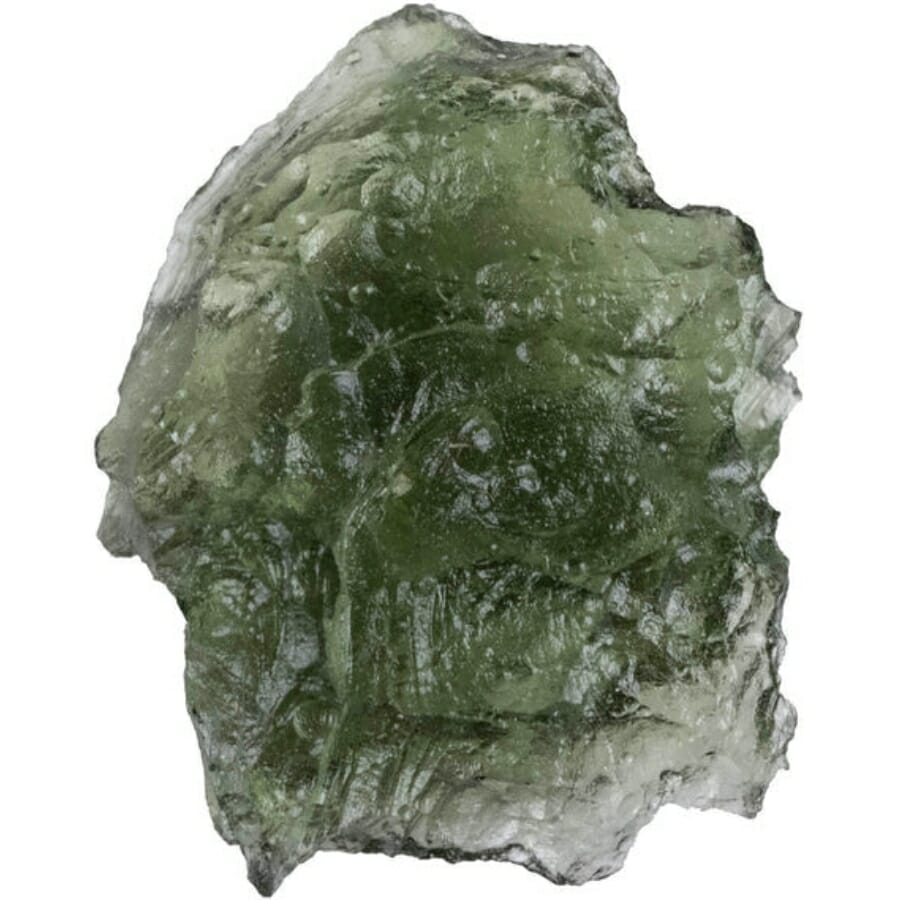
Malachite’s story begins deep where water and copper get together. Over time, when water containing a bit of carbon dioxide flows over copper deposits, it starts to form.
It’s a slow formation process overall. As the water moves and the copper reacts with it, we get layers and layers of this beautiful green mineral.
Switching to moldavite, you’ll be amazed as its origin is like something out of a sci-fi movie. Around 15 million years ago, a giant meteorite crashed into Earth, right in the area that’s now southern Germany.
This massive impact was so hot and powerful that it melted the rocks on the ground. These melted rocks then flew up into the air and cooled down super quickly before landing back. And that’s how moldavite was born.
Streak – Malachite leaves a light green streak
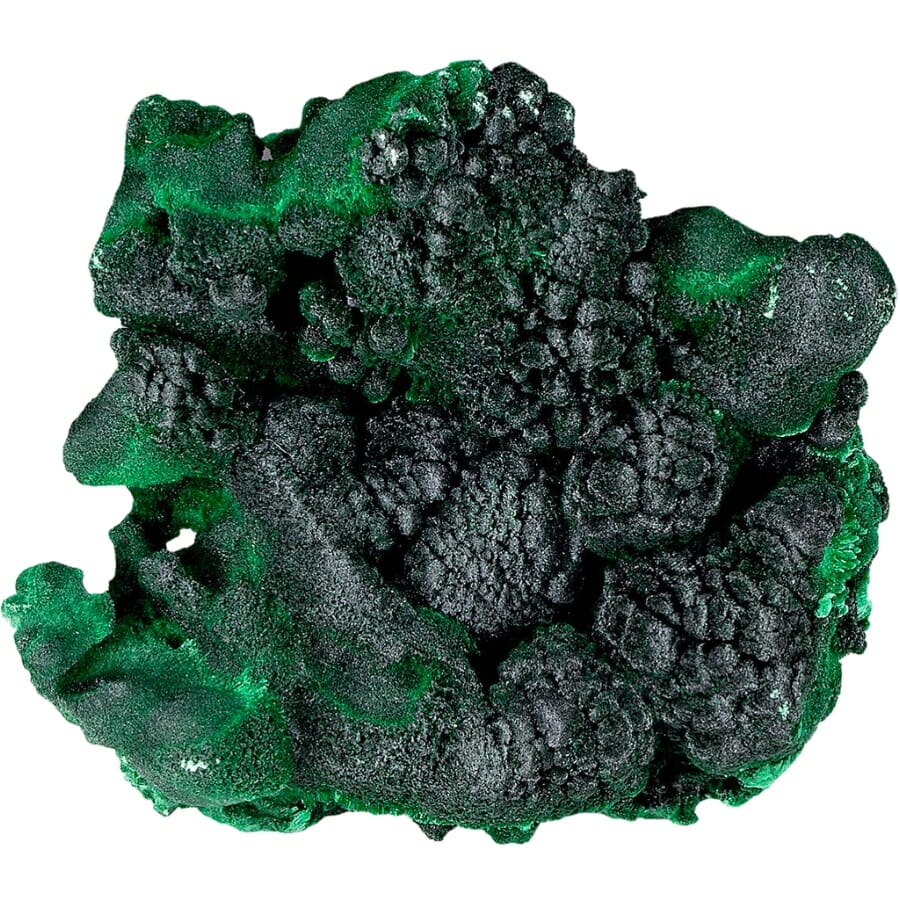
Imagine you have a white tile and you take a mineral and scratch it across the tile. The color of the mark or line it leaves behind is called its streak.
Even though malachite is a vibrant green when you look at it, it has a little surprise when it comes to its streak. When you scratch it on a white tile, it leaves behind a light green streak.
Moldavite, though, is a little different. If you tried to do a streak test with it, it might not leave much of a mark at all. That’s because moldavite is more like glass, and glass doesn’t usually leave a colorful streak on a tile.
Location – Moldavite is found in only one place
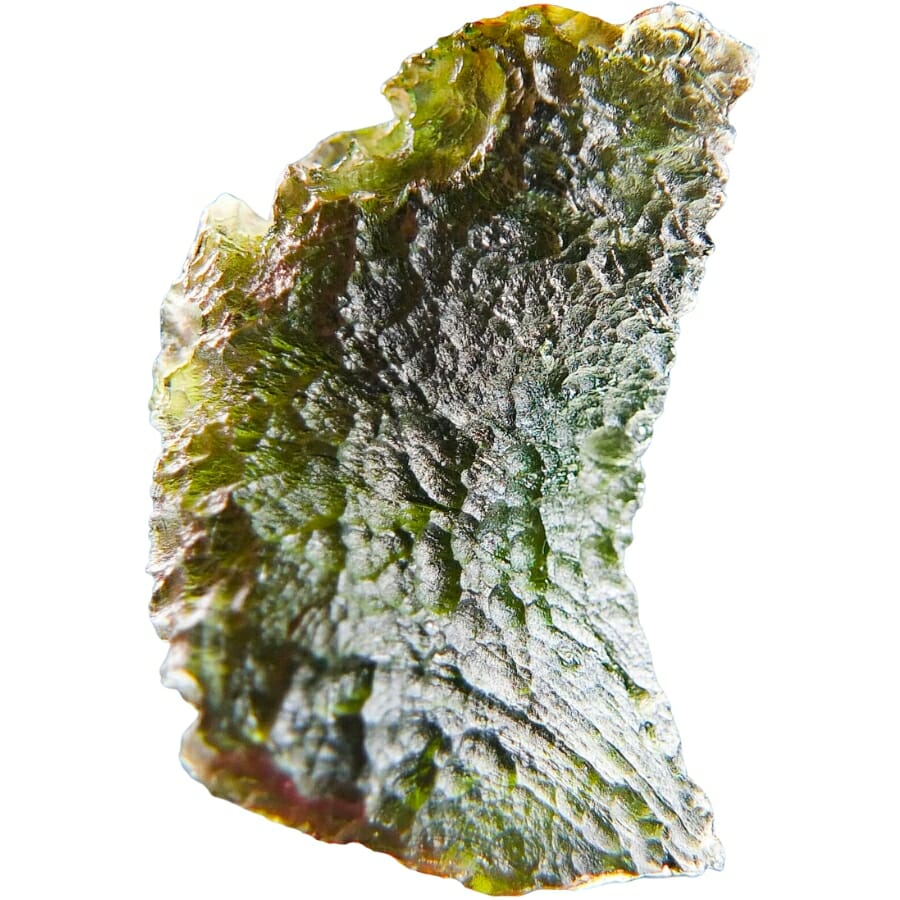
Malachite can be found in many parts of the globe. Some of the most famous spots are in the Congo in Africa, where big and beautiful pieces are found.
But that’s not the only place! Malachite is also found in Russia, Australia, and even in some parts of the United States. If you’re curious about the best places to find malachite here, check out our article.
Moldavite, on the other hand, is way pickier about where it hangs out. Because of its formation, it’s only found in a specific area called the Moldau River Valley in the Czech Republic.
Price – Malachite is more affordable than moldavite
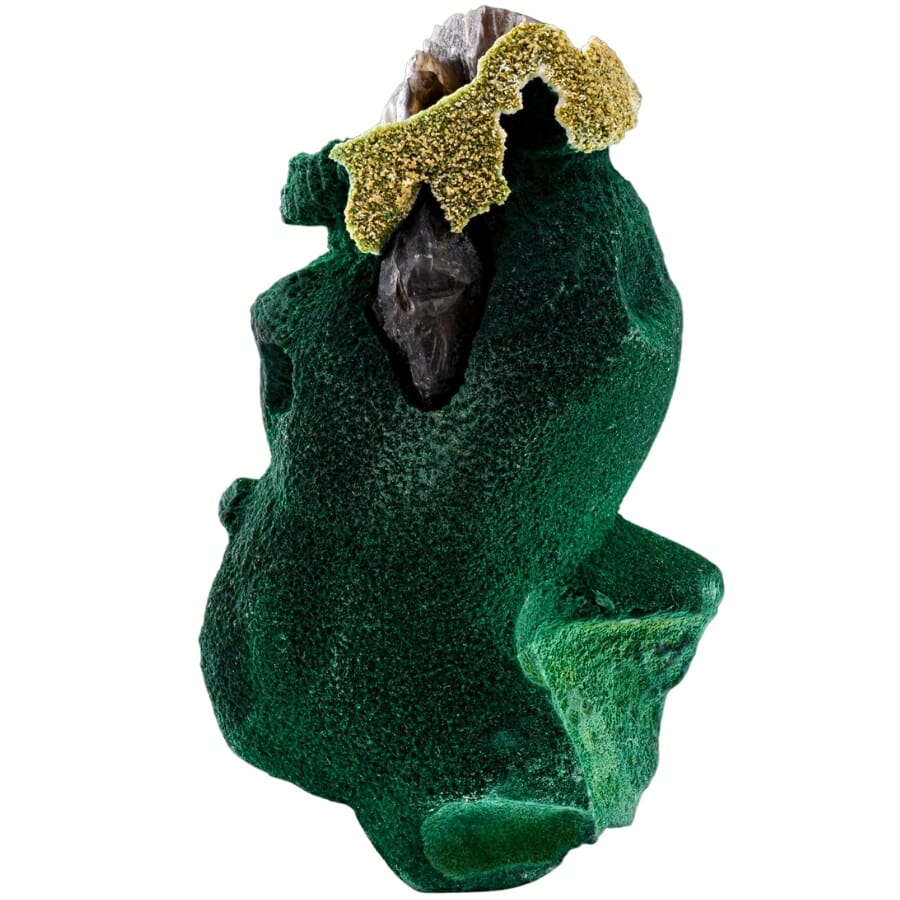
The price of malachite can change depending on a few things. If you have a small piece that’s not super bright or shiny, it might be more affordable. But if you have a big, bright, and shiny piece, it could cost more.
This is because people often look for the prettiest pieces for jewelry or decoration. But in general, malachite can be found at a range of prices, so there’s usually something for everyone’s budget.
In contrast, moldavite is a bit of a superstar in the mineral world, and its price shows it. Because it’s rare and has an awesome space story, it’s often more expensive than malachite.
Plus, since moldvite is only found in one spot, that adds to its high price. People love having a piece of “space glass”! But be careful: because this rock is so popular, there are fake pieces out there.
Malachite vs Moldavite – The Similarities
In comparing moldavite vs malachite, we also found some amazing similarities between these two green treasures, such as:
Fluorescence – Moldavite and malachite both don’t glow under UV light
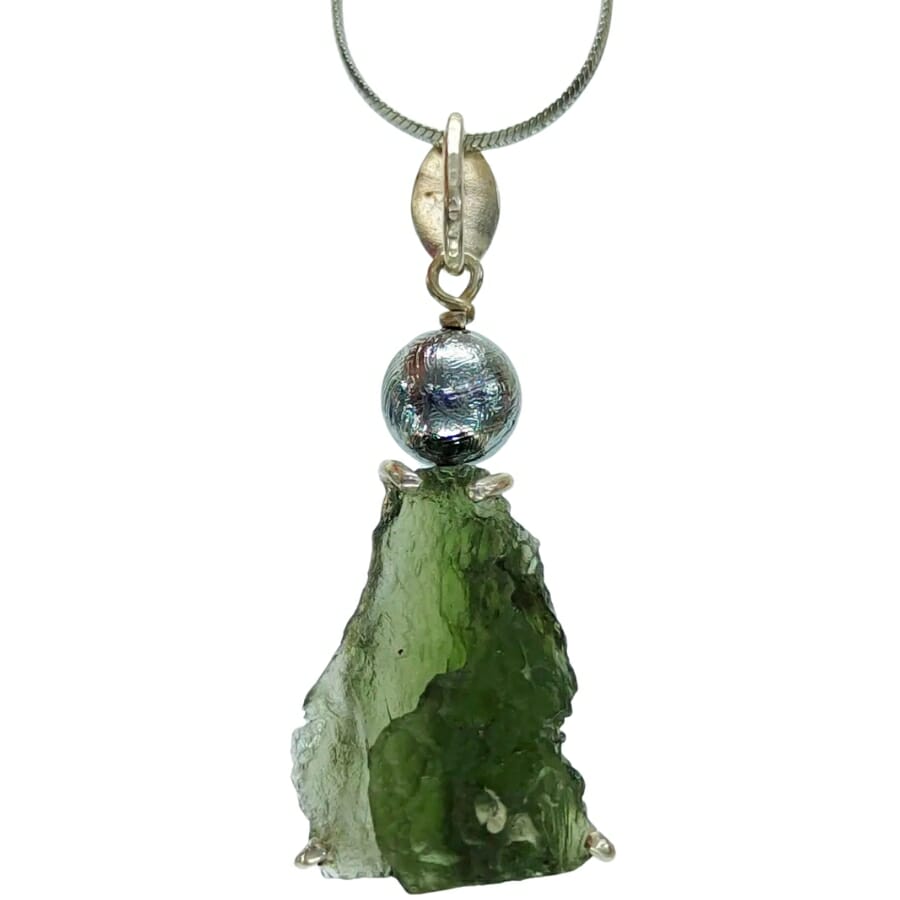
Fluorescence is the ability of some minerals to glow under a black light.
Here’s a fun fact: both malachite and moldavite are pretty similar when it comes to fluorescence. How? Well, neither of them are big show-off in this department.
If you took both malachite and moldavite to a glow-in-the-dark party with a black light, they’d probably be the quiet ones, not lighting up much at all.
Even without the glow, though, they’re still fascinating and have lots of amazing stories to tell.
Magnetism – Neither malachite nor moldavite are magnetic
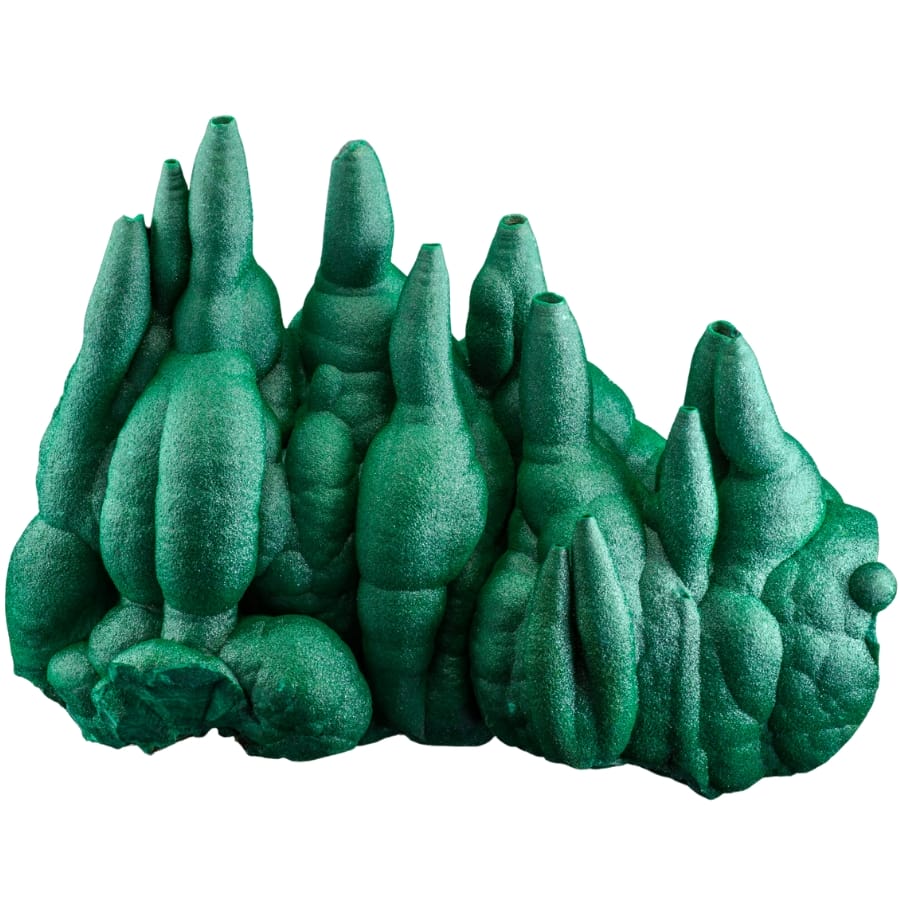
Magnetism is like that invisible force that makes magnets stick to your fridge. Ever wonder if minerals can be magnetic too?
If we zoom in on malachite and moldavite, the fun thing is these two minerals are like buddies when it comes to magnetism. Why? Because neither malachite nor moldavite is magnetic.
Malachite is made mostly of copper, which isn’t magnetic. So if you tried to stick a piece of this rock to a magnet, it would be like trying to make two pieces of paper stick together— it just won’t happen.
The same goes for moldavite. Even with its cool space formation story, it won’t be attracted to or stick to a magnet.
Conductivity – Both moldavite and malachite are insulators
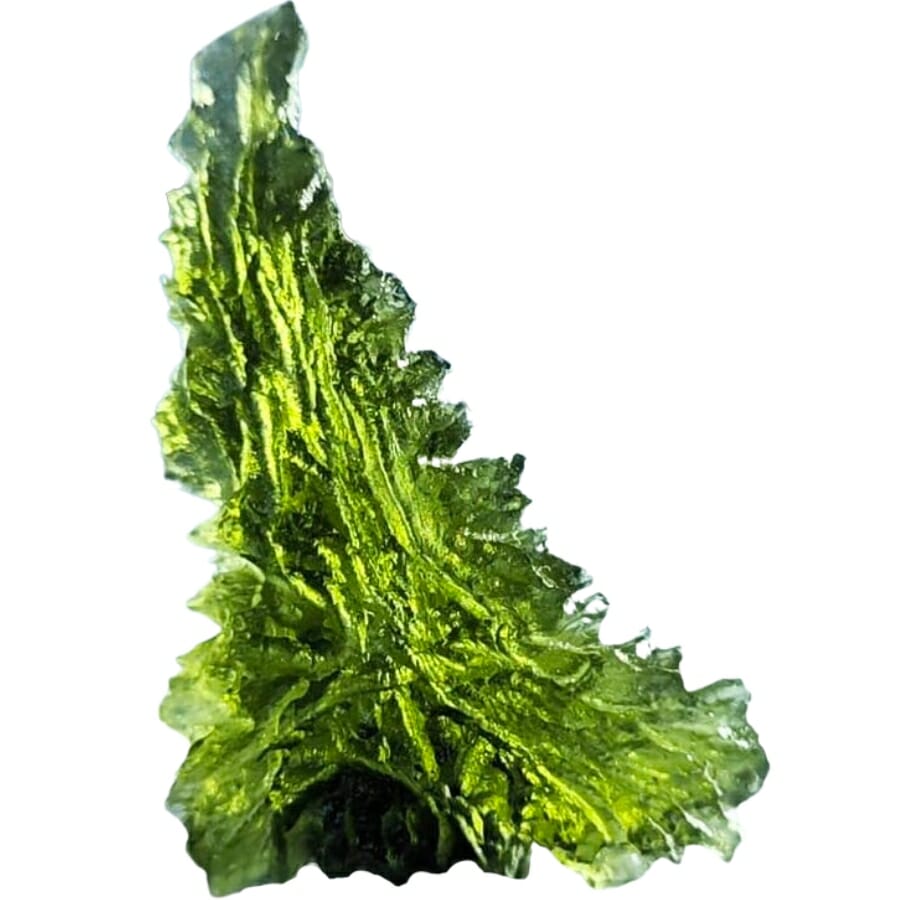
Conductivity measures how well something lets electricity pass through it. Think of it like a race track: some materials let electricity race through super-fast, while others make it slow down or even stop.
When it comes to conductivity, malachite and moldavite are the same. Malachite is mostly made of copper, which is known for being a great conductor of electricity. It’s used in a lot of wires and cables.
But here’s the twist: even though malachite has copper in it, it’s not pure copper. The copper in malachite is mixed with other stuff, which makes this rock not so great at conducting electricity.
Moldavite, which looks a bit like green glass, is also not good at letting electricity pass through just like most glass.
The Easiest Ways To Tell Malachite and Moldavite Apart
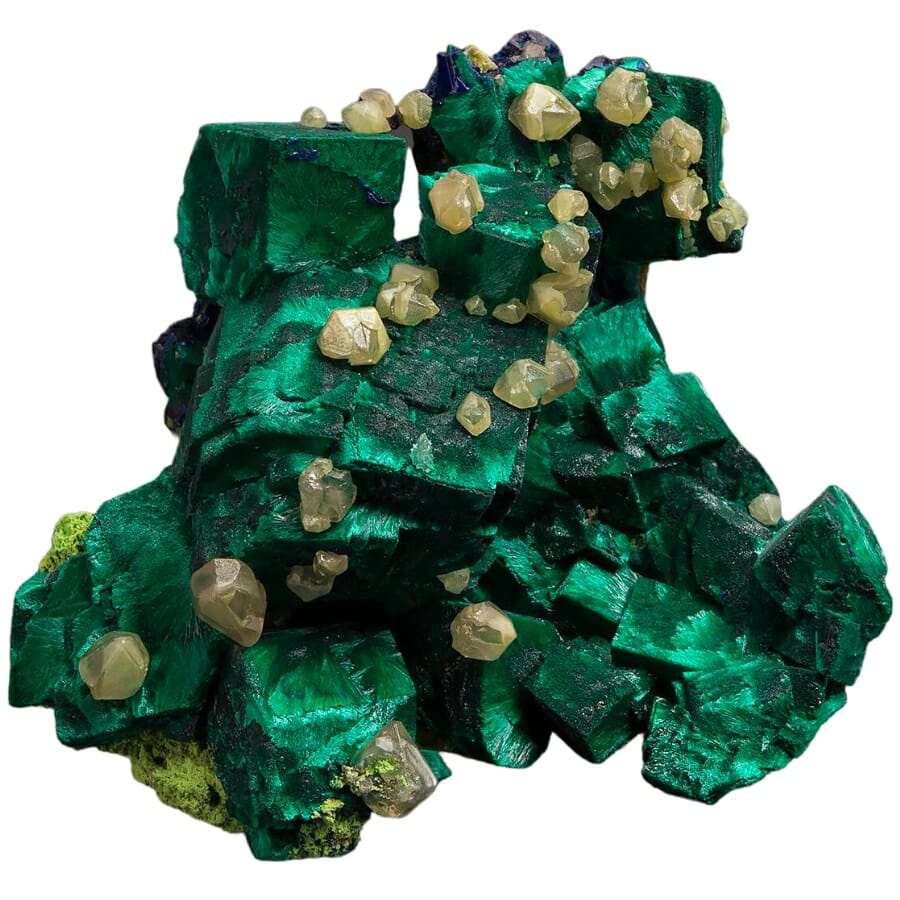
In addition to the many similarities and differences between malachite and moldavite, here are some practical ways you can tell if a certain specimen is either of these two:
Look at the colors and patterns
Malachite is famous for its bands or circles of different shades of green. If you see a stone with a bunch of wavy green lines or patterns, it’s probably this rock.
On the other hand, moldavite usually has a more consistent green color throughout, often resembling green glass.
Feel the texture
Give both a gentle touch. Malachite is smoother and might even feel a bit like a polished stone.
Moldavite, however, has a more sculpted surface because of how it formed from a meteorite impact. It’s got little nooks and crannies that give it a unique, almost bumpy feel.
Look at its shine
When light hits the rock, how does it look? This will also give you a clue on what your specimen is.
Malachite has a silky luster. It shines, but not like glass. Moldavite, on the other hand, looks more like green bottle glass, especially if you hold it up to the light.

